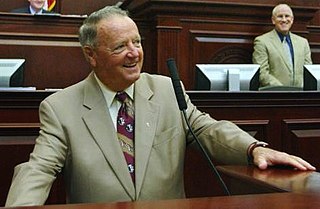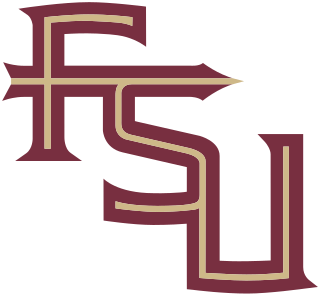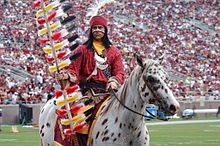
A mascot is any human, animal, or object thought to bring luck, or anything used to represent a group with a common public identity, such as a school, sports team, society, military unit, or brand name. Mascots are also used as fictional, representative spokespeople for consumer products.

Osceola, named Billy Powell at birth in Alabama, became an influential leader of the Seminole people in Florida. His mother was Muscogee, and his great-grandfather was a Scotsman, James McQueen. He was reared by his mother in the Creek (Muscogee) tradition. When he was a child, they migrated to Florida with other Red Stick refugees, led by a relative, Peter McQueen, after their group's defeat in 1814 in the Creek Wars. There they became part of what was known as the Seminole people.

Robert Cleckler Bowden was an American college football coach. Bowden coached the Florida State Seminoles of Florida State University (FSU) from 1976 to 2009 and is considered one of the greatest college football coaches of all time for his accomplishments with the Seminoles.

The Florida State Seminoles are the athletic teams representing Florida State University located in Tallahassee, Florida. They compete as a member of the National Collegiate Athletic Association (NCAA) Division I level, primarily competing in the Atlantic Coast Conference (ACC) for all sports since the 1991–92 season; within the Atlantic Division in any sports split into a divisional format since the 2005–06 season.

Doak S. Campbell Stadium, popularly known as "Doak", is a football stadium on the campus of Florida State University in Tallahassee, Florida. It is the home field of the Florida State Seminoles football team of the Atlantic Coast Conference (ACC).

Thomas Kent Wetherell was an American politician and educator. He served as a member of the Florida House of Representatives from 1980 to 1992, and was president of Florida State University from 2003 through 2009.

The Florida State University Marching Chiefs is the official marching band of Florida State University. The band has served in this capacity since the 1940s and continues to perform at all home football games as well as several away games each year. There are 420+ members, or Chiefs, as members are sometimes known, in the band who hail from almost every academic department within the university.

Charlene Teters is a Native American artist, educator, and lecturer. Her paintings and art installations have been featured in over 21 major exhibitions, commissions, and collections. She is a member of the Spokane Tribe, and her Spokane name is Slum Tah. She was born and raised in Spokane, Washington, near the Spokane Indian Reservation.

The 2006 Florida State Seminoles football team represented Florida State University during the 2006 NCAA Division I-A football season. The team was coached by Bobby Bowden and played their home games at Doak Campbell Stadium in Tallahassee, Florida. They were members of the Atlantic Coast Conference (ACC) and the Atlantic Division.

The Florida State Seminoles football team represents Florida State University in the sport of American football. The Seminoles compete in the NCAA Division I Football Bowl Subdivision (FBS) of the National Collegiate Athletic Association (NCAA) and the Atlantic Coast Conference (ACC). The team is currently coached by Mike Norvell, and plays home games at Doak Campbell Stadium, the 15th largest stadium in college football, located on-campus in Tallahassee, Florida. The Seminoles previously competed as part of the ACC Atlantic Division.

The Florida State Seminoles men's basketball team represents Florida State University in the intercollegiate sport of basketball. The Seminoles compete in the National Collegiate Athletic Association (NCAA) Division I and the Atlantic Coast Conference (ACC).
The Seminole Tribe of Florida is a federally recognized Seminole tribe based in the U.S. state of Florida. Together with the Seminole Nation of Oklahoma and the Miccosukee Tribe of Indians of Florida, it is one of three federally recognized Seminole entities. It received that status in 1957. Today, it has six Indian reservations in Florida.

Sammy Seminole was the first mascot of the Florida State University Seminoles. He was introduced in 1958 and was retired in 1972 in an effort to find a less insensitive mascot.

The Florida State–Miami football rivalry is an American college football rivalry between the Florida State Seminoles football team of Florida State University and Miami Hurricanes football team of the University of Miami. Since the late 1980s, one or both squads have been highly ranked entering the game, adding national championship implications to an already heated rivalry. Kicks have played an important role in the series with many wide right, wide left, blocks and other mistakes occurring with the game in the balance. Miami leads the series 35–33 through the 2023 season.
David Narcomey is a member of the Seminole Nation of Oklahoma and an activist who was the regional director of the North Florida chapter of the American Indian Movement or AIM.

The 1989 Florida State Seminoles football team represented Florida State University in the 1989 NCAA Division I-A football season. The team was coached by Bobby Bowden and played their home games at Doak Campbell Stadium.

Odell Haggins Jr. is an American football coach and former player. He is the associate head football coach and defensive tackles coach at Florida State University. Haggins has coached at Florida State since 1994 and has served two stints as interim head coach, for the final two games of the 2017 season, following the resignation of Jimbo Fisher, and the final four games of the 2019 season, after the firing of Willie Taggart.
In 2005 the National Collegiate Athletic Association (NCAA) distributed a "self evaluation" to its member institutions for teams to examine the use of potentially offensive imagery with their mascot choice. This examination was done in accordance with NCAA policy that requires each member institution to maintain an "atmosphere of respect for and sensitivity to the dignity of every person." Fourteen schools either removed all references to Native American culture or were deemed not to have references to Native American culture as part of their athletics programs. Subsequently, 19 teams were cited as having potentially "hostile or abusive" names, mascots, or images, that would be banned from displaying them during post-season play, and prohibited from hosting tournaments.















